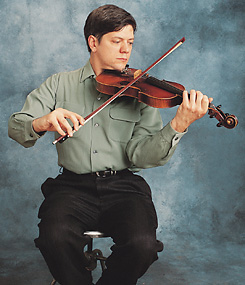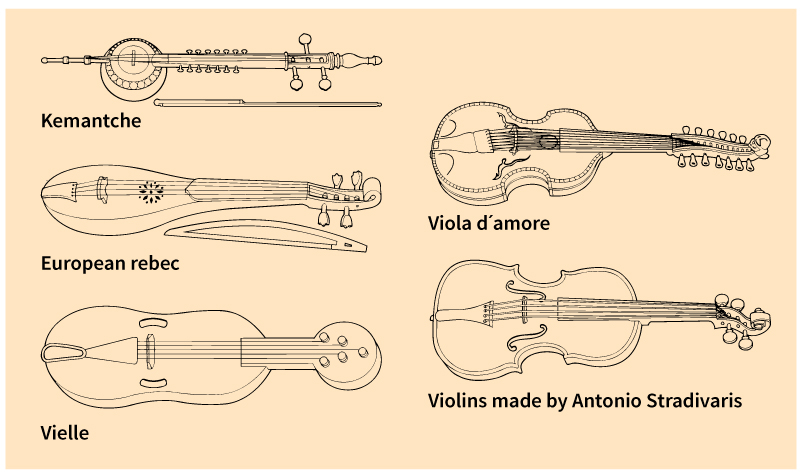Violin is a stringed instrument that is played with a bow. It is probably the best known and most widely used of all orchestral instruments. Some of the greatest music in the world owes much of its beauty to the violin. Such music may be the sound of a mighty orchestra, with dozens of violins playing together. Or it may be the music produced by one great master playing alone on a violin to a hushed audience.

Several other instruments are similar to the violin in construction and in method of playing. These include the cello and viola. They are considered members of the violin family.
Music for the violin covers a wide range. Some composers, such as Johann Sebastian Bach, Eugene Ysaye, and Bela Bartok, have written music for the violin alone. Many composers have written pieces for the violin with piano or orchestral accompaniment. The violin also has an important role as part of a group of instruments, as in an orchestra or in a string quartet.
Parts of the violin.
A violin is a special kind of box that amplifies (makes louder) the sound of the strings stretched across it. If you stretch a piece of string tightly and then pluck it, you will hear a faint note. If you stretch it across a wooden box, you will hear a much louder note. A violin maker uses soft pine or spruce for the belly (front) of the violin, and maple or sycamore for the back and the ribs (sides). The head (scroll and pegbox) and neck are made of maple. The graceful shapes of the back and belly are carved out of solid pieces of wood. The violin maker cuts two f-holes in the belly to allow the sound to escape, and makes the finger board and the tailpiece (string-holder) of ebony. Ebony is a hard wood that will be long lasting. The violin maker glues the violin parts together, using no nails or screws.
The violin has four strings, which are tuned in the interval of a fifth from each other. The first (E) string is generally made of steel. The second (A) string and the third (D) string are sometimes made of plain catgut, a material made from the intestines of sheep. But most players prefer to use A or D strings made of a thinner gut overwound with fine aluminum wire. Synthetic materials such as nylon are also used. The fourth (G) string is generally made of gut covered with silver or copper wire. The strings are attached to pegs set in the head. The player tightens the strings with these pegs to tune them to the correct notes.
There are two other important parts of the violin that are not permanently glued to the body. The bridge stands on the belly, midway between the two f-holes. It supports the strings. A pattern of holes is cut into the bridge to give it greater flexibility. The sound-post, a thin rod of pine, is wedged between the back and the belly underneath the bridge, inside the violin. The sound-post conducts the sound from the front to the back of the violin. It also supports the belly against the pressure of the strings. The sound-post is slightly behind one foot of the bridge. The bass-bar, a bar of pine that is glued on the underside of the belly, gives further support for the belly. It runs lengthwise underneath the other foot of the bridge.
The bow
is a curved, springy stick about 27 inches (69 centimeters) long that has a flat ribbon of hair attached to it. This ribbon consists of more than 150 horsehairs. The hair is attached to the point of the bow and to a sliding wood block called a frog or nut at the other end, near the point at which the violinist holds the bow. By turning a screw set into the end of the bow, the player can move the frog back and forth to tighten the hair against the spring of the bow. The bow is made of Pernambuco wood, a light, springy wood from a tree that grows in Brazil.
Playing the violin.
The player tucks the end of the violin between the chin and the left shoulder. To obtain a good grip, the player uses a chin-rest clamped to the top of the violin, and a shoulder-rest or a pad between the back of the violin and the shoulder. The violin should be supported entirely without the aid of the player’s left hand. The bow is held in the player’s right hand.
Loading the player...Violin
The player makes the strings of the violin vibrate by drawing the hair of the bow across them. Each of the separate strands of hair on the bow is rough, with minute projections. These projections make the strings vibrate as the bow slides over them. The player can vary the loudness of the tone and get other special effects by the way in which the bow is drawn across the strings. The player can also pluck the strings with the fingers, a form of violin playing that is known as pizzicato.
Violinists practice for years to perfect their skills, but very little strength is required to play the violin well. In fact, improvement is usually the result of using less tension in the hands, arms, and body. The finest violinists make playing look easy, with a minimum of muscle activity.
The strings of the violin give the player four notes. To obtain other notes, the player shortens the vibrating length of the strings by pressing them down on the finger board with the fingers of the left hand. Flutelike tones called harmonics can be produced by touching the strings lightly in certain places.
History.
Musicians have used many kinds of stringed instruments, such as harps and lyres, for thousands of years. But no one knows when players began to use bows, instead of just plucking the strings. Chinese players used bowed instruments in the A.D. 900’s. A hundred years later, musicians used forms of bowed instruments in many countries of Asia, Europe, and northern Africa. In the 1400’s, players started using bows to play instruments of the guitar family. These bowed guitars developed into the instruments called viols.

Violins date from the 1500’s. They were developed from the early bowed instruments. For many years, viols and violins developed side by side, each influencing the other. But by the late 1600’s, most musicians favored the violin family, and the viols dropped out of use.
The little Italian town of Cremona became the most important center of violin making. Members of the Amati family made fine instruments there in the late 1500’s and early 1600’s. In the 1600’s, Antonio Stradivari, a pupil of the Amatis, perfected the design of the violin and produced some of the finest violins ever made. Another great family was that of Guarneri. The violins of Giuseppe Guarneri, known as Guarneri del Gesu, rival those of Stradivari for tone. A Frenchman, Francois Tourte, perfected the bow in the late 1700’s.
From the 1600’s to the early 1800’s, many outstanding violinists were also the main composers for violin. Their works led to developments in playing technique Among the most important of these composers were Arcangelo Corelli, Niccolò Paganini, Giuseppe Tartini, Giovanni Viotti, and Antonio Vivaldi of Italy and Rodolphe Kreutzer and Pierre Rode of France. Viotti has been called the father of modern violin playing. He greatly improved and extended the use of the violin bow.
There is much interest today in performing violin music composed in the 1700’s on instruments of that period. Their thinner wood, the lighter bows, and the gut strings then widely used result in a more gentle sound, especially when accompanied by a harpsichord rather than a modern piano. In the 1900’s and early 2000’s, the violin also became a significant instrument in nonclassical music. For example, it is a major solo instrument in folk music and country music, where it is often called a fiddle. There have also been a number of skillful violinists in jazz.
